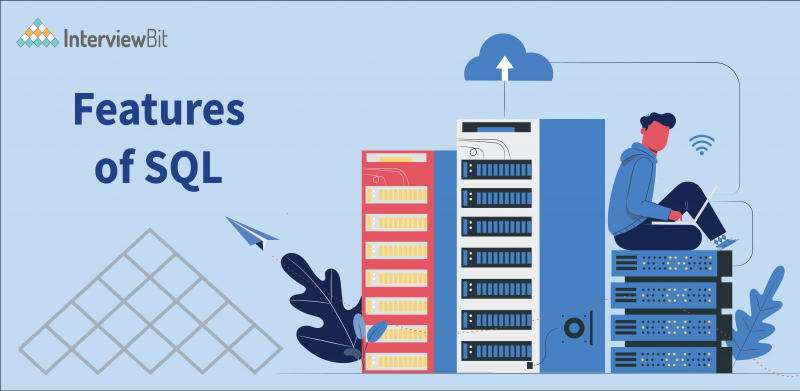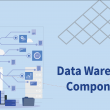- Introduction
- What are Functions?
- Features of SQL
- 1. Data Definition Language(DDL):
- 2. Data Manipulation Language(DML)
- 3. Relational Foundation
- 4. High-performance
- 5. Scalability
- 6. Security and authentication
- 7. Vendor Independence
- 8. Portability across different computer systems
- 9. IBM Endorsement and Commitment (DB2)
- 10. English-Like Structure
- 11. Programmatic Database Access
- 12. Transaction Control Language:
- 13. Various perspectives on data
- 14. Dynamic
- 15. Client/Server Architecture
- 16. Integration of SQL with Java
- Conclusion
- FAQs
- Q.1: What is special about SQL?
- Q.2: What is the original purpose of SQL?
- Q.3: What are the benefits of SQL?
- Additional Resources
Introduction
Data is all around us. We used to store data on paper in big filing cabinets but eventually, we store them online in what we call databases. To manage our databases, we use a software application called a Database Management System or DBMS. We connect to a database management system and give it instructions for querying or modifying data. The DBMS executes our instructions and sends the results back. Now we have several database management systems out there, and these are classified into two categories, relational and non-relational(also called NoSQL). The data in RDBMS is stored in database objects called tables that are linked to each other using relationships. A table is a collection of related data entries and it consists of columns and rows” for providing more information. That’s why we call these databases relational databases.
But the question arises: How do we easily pull the data from the database?
That’s what SQL is for.
Confused about your next job?
SQL or Structured Query Language is the language that we use to work with these relational database management systems.
SQL(Originally called sequel) is a language that communicates with databases. Most relational databases, including MySQL, ORACLE, SQL Server, etc., support (SQL) query language.
Note: SQL is not case-sensitive.
SQL was first developed by IBM for querying and altering relational databases, using declarative statements.SQL became a standard of the American National Standards Institute (ANSI) in 1986, and of the International Organization for Standardization (ISO) in 1987. Although it is often called a “query language”, SQL is much more than that. SQL can define data structure, modify data in a database, specify security constraints, and can perform many more tasks such as
- SQL can retrieve data from a database
- SQL can insert records in a database
- SQL can update records in a database
- SQL can delete records from a database
- SQL can create new databases
- SQL can create new tables in a database
- SQL can create stored procedures in a database
- SQL can create views in a database
- SQL can set permissions on tables, procedures, and views
- SQL can execute queries against a database
Before we delve into the different features offered by SQL, let us understand what are functions.
What are Functions?
Functions are methods used to perform data operations. SQL has many in-built functions used to perform string concatenations, mathematical calculations, etc.
SQL functions are categorized into the following categories:
- Aggregate Functions
- Scalar Functions
Let us look into each one of them, one by one.
1. Aggregate SQL Functions
An aggregate function in SQL calculates a group of values and returns a single result.
Following are a few of the most commonly used Aggregate Functions:
| Function | Description |
| SUM() | SUM() is used to return the sum of a group of values. |
| COUNT() | Returns the number of rows either based on a condition or without a condition. |
| AVG() | AVG() is used to calculate the average value of a numeric column. |
| MIN() | MIN() function returns the minimum value of a column. |
| MAX() | MAX() function returns a maximum value of a column. |
| FIRST() | FIRST() is used to return the first value of the column. |
| LAST() | LAST() function returns the last value of the column. |
2. Scalar SQL Functions
SQL Scalar Functions return a single value based on the given input value.
Following are a few of the most commonly used Aggregate Functions
| LCASE() | LCASE() is used to convert string column values to lowercase |
| UCASE() | This function is used to convert a string column values to Uppercase. |
| LEN() | LEN() returns the length of the text values in the column. |
| MID() | MID() extracts substrings in SQL from column values having String data type. |
| ROUND() | Rounds off a numeric value to the nearest integer. |
| NOW() | NOW() function is used to return the current system date and time. |
| FORMAT() | FORMAT() is used to format how a field must be displayed. |
Now that we have a fair idea about Structured Query Language(SQL), you must be thinking “What are the features of SQL?”.
So let’s discuss all the features of SQL one by one.
Features of SQL
1. Data Definition Language(DDL):
SQL provides many commands, one of which is Data Definition Language(DDL).
Formal definition: DDL stands for Data Definition Language. It provides commands for defining relation schemas, deleting relations, and modifying relational schemas. All the structural operations performed on a database are controlled by this language. Sometimes it is also referred to as data description language.
There are 5 commands in DDL:
i) Create command:
If we want to make a new table, the create command is used.
Syntax: for creating a table
Create table table_name( Column1_name data_type(size); Column2_name data_type(size); ..........................);
ii) Drop command:
If we want to delete a table including all attributes then the drop command is used.
Syntax: for drop command
Droptable table_name;
Example:
To drop the table employee, the query would be like
Drop table employee;
iii) Alter:
The alter command is used to modify the structure of a table.
Syntax: to add a new column to a table
Alter table table_name Add new_col_name data_types(size); After col_name;
Example:
The following SQL adds an “Email” column to the “Customers” table:
Alter table Customers Add Email varchar(255);
iv) Rename:
The rename command is used to change the name of a table.
Syntax: for renaming a table
Rename table old table_name; To new_table_name;
v) Truncate:
The truncate command is used to delete all the data in a table without affecting the table structure.
Syntax: for using the truncate command
Truncate table table_name;
2. Data Manipulation Language(DML)
Formal definition: DML which stands for Data Manipulation Language is a computer programming language used for managing or manipulating data in a table.
Data manipulation language(DML) provides 4 commands:
i) Select command:
It is a very important command in SQL that is used to select a set of data or information from a table or simply we can say that it is used to query information from a table.
The syntax depends upon the requirement because the select command is used with different conditions and clauses.
So let’s see a basic syntax for displaying all the information in a table:
Select * from table_name;
Note: While using the select command, the table should not be empty.
ii) Insert command:
The insert command is used to add new records or rows to a table
Syntax: to use the insert command
Insert into table_name(column1_name,column2_name,.....) values (value1,value2,...);
iii) Update command:
The update command is used when we want to change or modify data in a table:
Syntax: to use the update command
Update table_name set column_name1=value1,column_name2=value2. ................................... Where condition;
iv) Delete command:
The delete command is used when we want to delete a record or data in a table.
Syntax: to use the delete command
Delete from table_name where condition;
3. Relational Foundation
SQL is mainly used for relational databases. A relational database’s tabular structure provides an intuitive user interface, making SQL easy to learn and use. Additionally, relational models have a strong theoretical foundation that has guided the development and implementation of relational databases. In the wake of the success of the relational model, SQL has become the database language for relational databases.
4. High-performance
A large amount of data is retrieved quickly and efficiently. In addition, simple operations like inserting, deleting, and manipulating data can also be accomplished in a short amount of time. The reason SQL is so fast is that for a database product to be successful, it must return sets of data quickly when queried. In most database organizations, many of the company’s brightest people work constantly on the query engine so it creates ‘optimal’ query plans that work quickly.
5. Scalability
SQL database is vertically scalable, which means that you can increase the load on a single server by adding more RAM, SSDs, or CPUs. Due to the way data is stored (related tables vs unrelated collections), SQL databases generally support vertical scaling only – horizontal scaling is only possible for NoSQL databases.
6. Security and authentication
SQL Server includes several security-enabling features, including encrypted communication over SSL/TLS, Windows Data Protection API (DPAPI) to encrypt data at rest, authentication, and authorization.
Authentication means a process of identifying a user or a person based on their username and password.SQL Server authenticates its users by their credentials.
SQL Server supports two authentication modes, Windows authentication mode, and mixed mode.
- Windows authentication is the default authentication method and is also known as integrated security because it is tightly integrated with Windows. Specific Windows user and group accounts are trusted to log in to SQL Server. Users who have already been authenticated do not need to provide additional credentials.
- Mixed-mode supports authentication both by Windows and by SQL Server. Usernames and passwords are maintained in SQL Server.
7. Vendor Independence
With SQL support available from all the major DBMS vendors, no new DBMS product has been highly successful over the last decade. It’s possible to migrate SQL-based databases and programs from one DBMS to another vendor’s DBMS with minimal conversion effort. Thus vendor independence is one of the most important features of SQL and an important reason for its early popularity.
8. Portability across different computer systems
SQL-based database products support a variety of platforms such as mainframes, PCs, workstations, specialized servers, and even handhelds.
Due to this feature of SQL:
- Applications that begin on single-user or departmental servers can be migrated to larger server systems as they grow.
- It is also possible to extract and download data from corporate SQL databases into departmental or personal databases.
- A prototype of a SQL-based database application can be developed on an affordable personal computer before it is passed to a more costly multiuser system.
9. IBM Endorsement and Commitment (DB2)
Researchers at IBM created SQL, which has since become a strategic product built on IBM’s flagship DB2 database. From personal computers to midrange systems to IBM mainframes, SQL is supported on all major IBM products. With IBM’s initial work, other database and system vendors followed IBM’s lead early on in the development of SQL and relational databases, and as a result of IBM’s wide support and commitment, SQL was accepted more quickly by the market. In addition to IBM’s products, the SQL-based products it has developed run on hardware from emerging competitors such as HP and Sun.
10. English-Like Structure
SQL is simple and easy to learn as it contains English-like sentences such as create, select, delete, update, etc. In SQL databases, columns and tables can have long, descriptive names. Therefore, most SQL statements have a clear meaning, allowing them to be interpreted as natural sentences.
11. Programmatic Database Access
Programmers use SQL to access databases when they write applications. In contrast to traditional databases in which one set of tools is for programmatic access and another for unscheduled requests, Interactive and programmatic access to the database is achieved by using the same SQL statements which allow database access parts of a program to be tested first with interactive SQL and then embedded into a program.
12. Transaction Control Language:
The propagation of a change in the database is called a transaction.
In DBMS, transactions are an important element, and to handle them, TCL(Transaction Control Language) is used, which includes commands such as commit, rollback, and savepoint.
Commit command:
The commit command is used to save the changes.
The syntax for commit command:
Commit;
Rollback command:
The rollback command is used to roll back the changes to the previous transaction.
The syntax for rollback command:
rollback;
Savepoint command:
The savepoint command is used when we want to go back to the previous transaction without going back to the entire transaction.
The syntax for savepoint command:
Savepoint savepoint_name;
13. Various perspectives on data
With SQL, the creator of a database can give different users different views of the database’s structure and content. For eg:-An organization’s database can be constructed in such a way that each user can access only his or her department’s data. Additionally, data from different tables in the database can be combined and displayed as a simple row/column table for the user.
14. Dynamic
One of the major advantages of SQL over other static databases is that, even while users are accessing database content, it is possible to change and expand a database’s structure dynamically. As a result, SQL provides maximum flexibility, allowing online applications to continue uninterrupted while a database can adapt to changing requirements.
15. Client/Server Architecture
A client-server relationship is defined as a relationship in which a client (many) is connected to a server (one).
Applications based on distributed, client/server architectures are natural candidates for SQL implementation. A SQL database serves as the glue between “front-end” computer systems geared toward user interaction and “back-end” systems that focus on database management, giving each system the ability to do what it does best. In addition, SQL allows personal computers to serve as a front end to network servers or mainframe databases, allowing access to corporate data from a personal computer application.
16. Integration of SQL with Java
In recent years, the integration of SQL with Java has been a major area of SQL development. Sun Microsystems (the developer of JAVA) introduced Java Database Connectivity JDBC(a standard API that allows Java programs to use SQL for database access), to link the Java language to existing relational databases. It ensured that SQL was still relevant in the new era of Java-based programming.
Conclusion
In today’s technology environment, every application or development tool, regardless of how its interface looks, ends up translating queries and other commands into SQL. The features of SQL are plentiful and could be discussed in greater detail but what we have discussed are the most common and important features of SQL due to which SQL has maintained its importance till now. No other alternative database system has achieved what SQL has due to these powerful features.
FAQs
Q.1: What is special about SQL?
- SQL is a domain-specific language. Unlike general-purpose languages, SQL is a nonprocedural language that is designed specifically to access data from normalized relational databases. It differs from other conventional programming languages primarily by specifying what data operations should be performed instead of how they should be performed.
- Abstract data manipulation code can be transformed into direct database operations by many advanced implementations that are both durable and efficient.
- The resources available and the number of trained software developers who know SQL are plentiful.
Q.2: What is the original purpose of SQL?
SQL is designed for managing data in a relational database management system (RDBMS), or for stream processing in an RDBMS and its main purpose is to enable users to query databases with more or less natural-language statements rather than complex mathematical notations.
Q.3: What are the benefits of SQL?
SQL has many benefits such as
- SQL is portable
- SQL provides high-security
- SQL processes query quickly.
- SQL doesn’t require coding skills.
- SQL uses standardized language
- SQL provides multiple data views
- SQL has open-source code
- SQL is highly interactive
Business journals are filled with stories about the importance of SQL. Almost every business has gone digital. Digitization means data – and data rises to databases, which require SQL for effective access. Almost every business journal mentions analytics or business intelligence (BI). As companies strive to do more with their information, they will need more analysts who can access and analyze that data. You can accomplish all of this with SQL, the key skill.







 Join WhatsApp Group
Join WhatsApp Group


